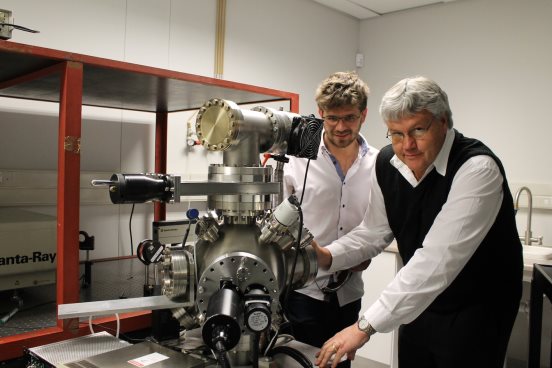
POWER TO THE PEOPLE! SCIENTIFIC BREAKTHROUGH AT SOUTH AFRICAN UNIVERSITY TO PROVIDE SEE-THROUGH GLASS SOLAR POWER FOR HOMES, PHONES AND CARS
A NEW TYPE OF CLEAR GLASS FOR WINDOWS THAT ALSO ACTS AS A SOLAR PANEL TO CAPTURE THE SUN’S ENERGY FOR BUILDINGS, MOBILE PHONES & ELECTRIC CARS IS SET TO EMERGE FROM A JOINT STUDY BETWEEN THE UNIVERSITIES OF THE FREE STATE IN SOUTH AFRICA AND GHENT IN BELGIUM.
A revolutionary new type of window glass – in effect a transparent solar panel - is the objective of joint research being done by the University of the Free State (UFS) in South Africa and Ghent University in Belgium.
A working model has been created which proves the viability of the process which now needs to be refined, made more efficient and brought to the market. It is hoped to achieve this within a decade.
This new product will have the capacity to revolutionise the generation of power cheaply from the sun to power homes, factories and cities in a new clean way.
Academics from the University of the Free State in South Africa, Professor Hendrik Swart and Lucas Erasmus are doing joint research with Ghent University in Belgium, to find solutions for energy production.
The two universities entered into an agreement recently for this research into electricity generation. The research is driven by the University of the Free State and was prompted by ever-rising electricity prices and growing demand for electricity production. South Africa lives with constant power outages which leaves people stuck in lifts and facing chaos on the roads as traffic lights cut out. Many people who can afford them now rely on generators.
Professor Hendrik Swart, senior professor in the Department of Physics at the University of the Free State and SARChI chair (South African Research Chairs Initiative) in Solid State Luminescent and Advanced Materials, says: “An innovation like this which can help to replace traditional means of carbon based fuel for power generation in our daily lives would be hugely welcome.”

Academics Lucas Erasmus (left) and Professor Hendrik Swart (right)
Swart explains the main objective of the research: “The idea is to develop glass that is transparent to visible light, just like the glass you find in the windows of buildings, motor vehicles and mobile electronic devices. However, by incorporating the right phosphor materials inside the glass, the light from the sun that is invisible to the human eye (ultraviolet and infrared light) can be collected, converted and concentrated to the sides of the glass panel where solar panels can be mounted.
This invisible light can then be used to generate electricity to power buildings, vehicles and electronic devices. The goal is therefore to create a type of transparent solar panel.”
Swart says this technology can be implemented in the building environment to meet the energy demands of the people inside the buildings. “The technology is also good news for the 4.7 billion cell phone users in the world, as it can be implemented in the screens of cell phones, where the sun or the ambient light of a room can be used to power the device without affecting its appearance,” he said.
Another possible application is in electric cars, where the windows can be used to help power the vehicle.
Lucas Erasmus who is working with Professor Swart adds: “We are also looking at implementing this idea into hard, durable plastics that can act as a replacement for zinc roofs. This will allow visible diffused light to enter housing and the invisible light can then be used to generate electricity. The device also concentrates the light from a large area to the small area on the sides where the solar panels are placed; therefore, reducing the number of solar panels needed and in return, reducing the cost.”
It is envisaged that the technology will take about a decade to refine and implement. This study is currently on-going, and UFS are experimenting and testing different materials in order to optimise the device in the laboratory. It then needs to be upscaled in order to test it in the field. “It is truly the technology of the future,” says
Erasmus.
The UFS envisages that the end result of this research will provide an attractive solution to address the energy demands of buildings, electric motor vehicles and mobile electronics without affecting their appearance.
According to Swart, the agreement entails a joint doctoral degree in which both universities will supervise the project and the awarding of the doctorate. Lucas Erasmus, a student at the UFS, has been tasked with the assignment to conduct research at both institutions.
Photographer:
Barend Nagel
Photo captions:
UFS Photo 1 and 2: UFS researchers Lucas Erasmus and Prof Hendrik Swart with the equipment used for the ground-breaking research.
Notes for Editors:
The University of the Free State:
115 years old (1904-2019)
7 faculties
114 departments
40, 491 total students
31, 135 Undergraduate students
7, 486 Postgraduate students
1, 870 International students
2, 521 permanent staff members
59 satellite campuses
157 renovated buildings (2012-2017)
12 new buildings (2012-2017)
1 200 works of art
1, 584 collaborating institutions
2, 751 co-authored publications from 2013-2018
240 postgraduate research degrees on average conferred per year
100.45% research output increase since 2010
Contacts